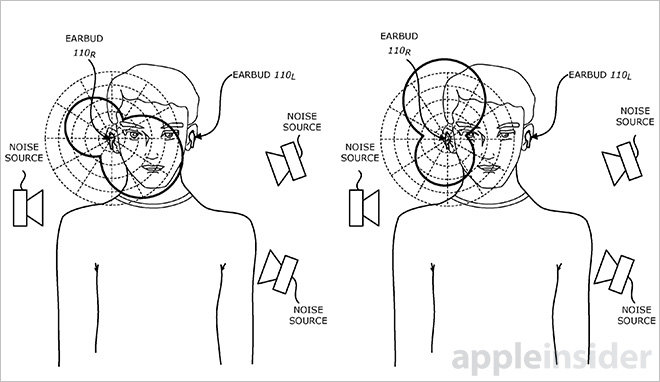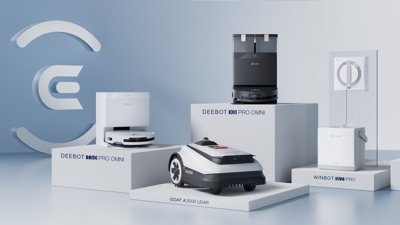According to a patent application published on Thursday, Apple is looking into advanced bone conduction technology that would enhance voice communications in an unannounced wireless earphone system.
Published by the U.S. Patent and Trademark Office, Apple's patent application for a "System and method of improving voice quality in a wireless headset with untethered earbuds of a mobile device" describes a system in which voice input is accepted by one of two earbuds and is passed along to a mobile device based on perceived quality. A variety of sensors, including an inertial sensor monitoring vibrations in a user's bone structure, help inform which signal to use.
Unlike traditional audio-based noise cancellation systems, Apple's version accounts for noise and wind level detected by internal earbud microphones and combines that information with accelerometer output, battery level and earbud position data. With distinct earbud subsystems at work, the design is capable of monitoring and selecting from two signal sources before applying a final noise reduction operation four outgoing audio.
In practice, both earbuds are outfitted with multiple onboard microphones, accelerometers, batteries, communications hardware and logic for audio signal processing. Noise, wind levels and an acoustic signal, in this case a user's voice, are captured by each earbud. At the same time, the accelerometer detects vibrations produced by a user's vocal chords as they modulate through bone and tissue, thus deciphering voiced speech and pitch.
In some embodiments, a first earbud sends acoustic information to a host iPhone after determining its noise and wind levels to be lower than those detected by a second earbud. Alternatively, a first earbud can transmit its acoustic signal and accelerometer data when the second earbud's accelerometer output is lower by a predetermined threshold. Voiced and unvoiced speech are respectively detected by the onboard accelerometer and microphone array.
The system also uses acoustic and inertial sensor data to determine if an earbud is actually in a user's ear, which would in turn default voice output to the second earbud. Power considerations are taken into account during the determination process to ensure uninterrupted service.
Today's patent illustrates ongoing work in the area of bone conduction technology, as Apple filed a similar application for accelerometer-assisted noise cancellation last September. The company has yet to bring such a device to market and its most advanced earphone designs still rely on cables, not including devices developed by Beats.
Apple's bone conduction wireless earbud patent application was first filed for in February 2014 and credits Sorin V. Dusan, Baptiste P. Paquier and Aram M. Lindahl as its inventors.
 Mikey Campbell
Mikey Campbell









-m.jpg)






 Wesley Hilliard
Wesley Hilliard
 Malcolm Owen
Malcolm Owen
 Andrew O'Hara
Andrew O'Hara



 Andrew Orr
Andrew Orr









8 Comments
I wondered when the Bone Phone would make a miniaturized comeback http://www.retrothing.com/2006/01/the_bone_fone_r.html
How about earphones that do double-duty and also clean out your ears as you use them? Wax in...wax out! Get Mr. Miyagi in the ads with a little digital trickery...
Back in 2013 when Google's patent filing for this technology became public I was nervous about the implementation. Google seemed to be throwing out ideas without truly considering the consequences of having people actually using the technology. Bone conduction technology never made it into Glass then Glass failed. Reading this information about Apple's technology does not make me nervous. I feel Apple has convinced me to trust it to get the technology right before turning it into a product.
[quote name="SpamSandwich" url="/t/187888/apple-researching-wireless-earphones-with-bone-conduction-noise-cancelling-tech#post_2766446"]How about earphones that do double-duty and also clean out your ears as you use them? Wax in...wax out! Get Mr. Miyagi in the ads with a little digital trickery...[/quote] Meh. How about ear buds that actually stay in my ear. The rest is earw...er...gravy.
[quote name="leavingthebigG" url="/t/187888/apple-researching-wireless-earphones-with-bone-conduction-noise-cancelling-tech#post_2766449"]Back in 2013 when Google's patent filing for this technology became public I was nervous about the implementation. Google seemed to be throwing out ideas without truly considering the consequences of having people actually using the technology. Bone conduction technology never made it into Glass then Glass failed. Reading this information about Apple's technology does not make me nervous. I feel Apple has convinced me to trust it to get the technology right before turning it into a product.[/quote] There's not just [B]one[/B] Google patent involving audio and bone conduction. There's dozens of 'em, most fairly recent but some going back aways. Seems to be an important research area for them. https://www.google.com/search?tbo=p&tbm=pts&hl=en&q=bone+conduction+audio+inassignee:Google&num=10&qscrl=1&gws_rd=ssl Apple's most recent filing is not their only one either. https://www.google.com/search?tbo=p&tbm=pts&hl=en&q=bone+conduction+audio+inassignee:Apple&num=10&qscrl=1&gws_rd=ssl In addition there's literally 100's from other companies. It's a minefield. https://www.google.com/search?tbo=p&tbm=pts&hl=en&q=bone+conduction+audio&num=10&qscrl=1&gws_rd=ssl#q=bone+conduction+audio&hl=en&tbm=pts&start=40